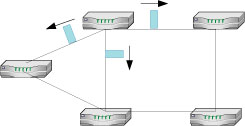When a host connects another host which belongs to different network, determining routers which IP datagram is forwarded is said routing. Each hosts and routers have routing tables which include necessary information for routing. There are two methods to make routing tables. One is that routing information is set for routers and hosts in advance. Another is dynamically making the routing table. Former is said static routing and later is said dynamic routing. In the current situation, the update of network and the extension of scalability are often done. Therefore, static routing method is not suitable because it need manual update when network framework is changed. In the past, several dynamic routing protocols are proposed. The most notable examples are RIP (Routing Information Protocol) and OSPF (Open Shortest Path First). RIP is suitable for small size networks. By RIP, the number of routers which IP datagram go through means cost, and the minimum-cost path is selected as a forwarding path. RIP has a merit of simple scheme and less information router handle, but also has demerit of taking long time to converge and not computing cost because of loop. While in OSPF method, the link state between nodes is applied as a metric, and each node determines the shortest path by making up network topology based the link state. OSPF takes in many functions that RIP doesn’t have. So, OSPF gathers attention as a routing protocol which take a major role of future network.

